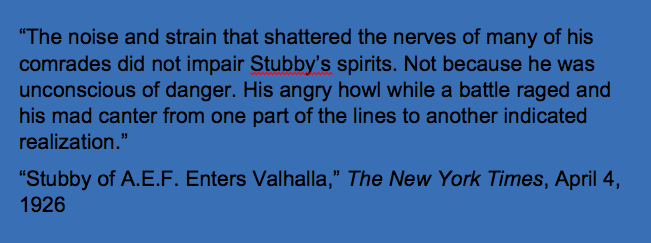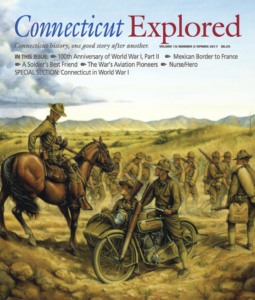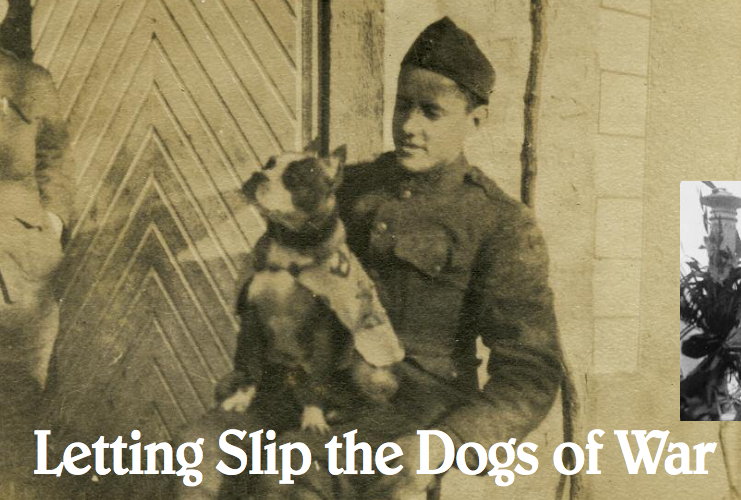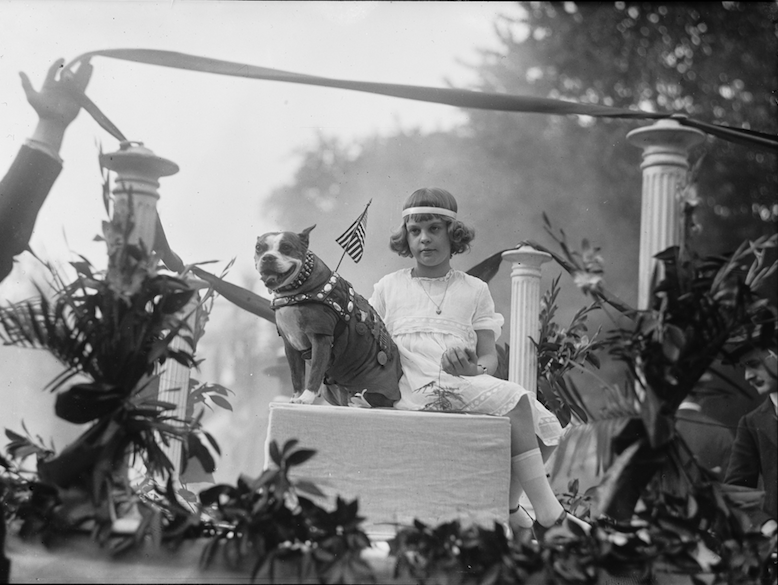By Sarajane Cedrone
(c) Connecticut Explored Inc. Spring 2017
SUBSCRIBE/BUY THE ISSUE
In 1917 Corporal Robert Conroy of the Connecticut National Guard’s 102nd Infantry 26th Yankee Division found new meaning in the phrase “man’s best friend.” One summer day, while Conroy was training with his regiment at Camp Yale near the Yale Bowl in New Haven, a bull terrier mutt wandered onto the field, scampering between the ranks of the drilling soldiers, stopping here and there to greet the men. Corporal Conroy took in the wild mutt—naming him “Stubby” for his squat, stunted tail—not knowing that by the end of their military tenure, his new pet would outrank him, earning the title “Sergeant Stubby.”
During the course of the 102nd’s training in New Haven in the summer of 1917 Stubby became the regiment’s unofficial mascot. He followed his new master in training drills day in and day out—until he learned to march in line, recognize bugle calls, and give his own version of a military salute.
When he shipped out to France in October 1917, Conroy refused to abandon his new companion. He smuggled Stubby overseas onboard the SS Minnesota.
 Stubby saw his first action on February 5, 1918, on the front lines of the Chemin des Dames. Conroy’s refusal to abandon his canine friend proved to be lucky not only for Stubby but for the other soldiers of the 102nd regiment, too. Stubby quickly learned to duck when the men ducked and was reported to have run up and down the lines, locating wounded soldiers and barking to call attention to them until help came. The dog was popular among the men and proved himself to be a sure-fire morale booster. Stubby’s New York Times obituary reported that Stubby once arrested a German spy by crunching down on his behind and refusing to relent until his regiment came to arrest the enemy. His bravery in battle earned him the title Sergeant Stubby, and a collection of medals to adorn his new military jacket—including three service stripes and a Purple Heart, according to the Connecticut State Library.
Stubby saw his first action on February 5, 1918, on the front lines of the Chemin des Dames. Conroy’s refusal to abandon his canine friend proved to be lucky not only for Stubby but for the other soldiers of the 102nd regiment, too. Stubby quickly learned to duck when the men ducked and was reported to have run up and down the lines, locating wounded soldiers and barking to call attention to them until help came. The dog was popular among the men and proved himself to be a sure-fire morale booster. Stubby’s New York Times obituary reported that Stubby once arrested a German spy by crunching down on his behind and refusing to relent until his regiment came to arrest the enemy. His bravery in battle earned him the title Sergeant Stubby, and a collection of medals to adorn his new military jacket—including three service stripes and a Purple Heart, according to the Connecticut State Library.
Meanwhile, back home, Sergeant Stubby’s popularity grew immensely not only in Connecticut but nationwide as newspaper articles and photos circulated about the 102nd Infantry’s war-dog. When the regiment returned home, Stubby marched in parades, rode on floats, and posed for pictures with his fellow soldiers. He was inducted into the American Legion and given a lifetime membership to the YMCA that included three bones per day. When Conroy enrolled in law school at Georgetown University, Stubby went with him, and he was quickly adopted as the school’s new mascot. He was known to push balls up and down the football field during half-time, according to the United States War Dogs Association.
But Stubby’s legacy did not end with celebrations, parades, and paparazzi. With 18 months in the army under his belt, Stubby remains to this day the most decorated canine in United States military history. His actions, and the use of war dogs in German and French armies during World War I, led to the creation of an official K-9 military unit in 1942, just in time for American involvement in World War II. To this day, the United States uses war dogs for their heightened sense of smell, acute hearing, and swift reflexes.
By the time Stubby died, in April 1926, the mutt had become such an iconic symbol of World War I that many newspapers across the country, including The Hartford Courant and The New York Times, published obituaries honoring the stowaway sergeant. Conroy donated his beloved pet’s remains to the Smithsonian, where Stubby was skinned and cremated; his ashes were placed inside a plaster cast of himself and his skin stretched over the cast, which wears the mutt’s original military jacket. The cast is available for loan when not on display. Stubby is currently on display in the Price of Freedom: Americans at War exhibition at the National Museum of American History.
when not on display. Stubby is currently on display in the Price of Freedom: Americans at War exhibition at the National Museum of American History.
Sarajane Cedrone was editorial assistant for Connecticut Explored while she worked on an M.A. in public history at Central Connecticut State University.


